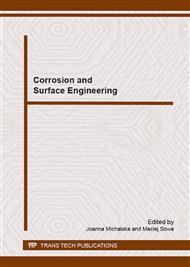p.471
p.475
p.479
p.483
p.487
p.491
p.495
p.499
p.503
Electrochemical Properties of cpTi with Modified Surface Used for Implants in Blood and Vascular System
Abstract:
In their works the authors presented results of tests conducted for titanium Grade4 after its surface modification with the application of anodic oxidation and sol-gel (SiO2 layer) methods. In order to verify the usefulness of the obtained surface layers potentiodynamic and impedance tests have been carried out. They have been conducted with the use of measurement set equipped with the POSTAT 302n potentiostat with the FRA2 attachment for impedance tests. Measurements have been taken in an environment simulating human blood – artificial serum having temperature of T = 37 degrees Centigrade. To identify phenomenon occurring at phases border samples have been subjected to 28-day exposition in the artificial serum. It has been found that in the case of anodic oxidation the value of voltage of 100 V has an advantageous influence on electrochemical properties of modified surfaces. On the other hand, in the case of the sol-gel method thin layer of SiO2 baked at temperature T = 430 degrees Centigrade has been characterised by the most advantageous set of electrochemical properties. The knowledge of proper parameters of creating of surface layers has direct influence on the product quality and thus, appropriate course of patient therapy process.
Info:
Periodical:
Pages:
487-490
Citation:
Online since:
January 2015
Keywords:
Price:
Сopyright:
© 2015 Trans Tech Publications Ltd. All Rights Reserved
Share:
Citation:


